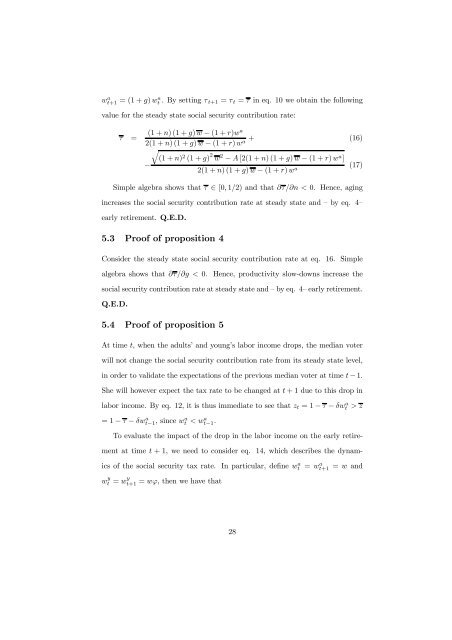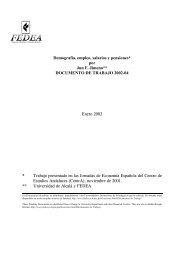The Evolution of Retirement by J. Ignacio Conde-Ruiz* Vincenzo ...
The Evolution of Retirement by J. Ignacio Conde-Ruiz* Vincenzo ...
The Evolution of Retirement by J. Ignacio Conde-Ruiz* Vincenzo ...
You also want an ePaper? Increase the reach of your titles
YUMPU automatically turns print PDFs into web optimized ePapers that Google loves.
w a t+1 =(1+g) w a t . By setting τ t+1 = τ t = τ in eq. 10 we obtain the following<br />
value for the steady state social security contribution rate:<br />
τ =<br />
(1 + n)(1+g) w − (1 + r)wa<br />
2(1 + n)(1+g) w − (1 + r) w a + (16)<br />
q<br />
(1 + n) 2 (1 + g) 2 w 2 − A [2(1 + n)(1+g) w − (1 + r) w a ]<br />
−<br />
2(1 + n)(1+g) w − (1 + r) w a (17)<br />
Simple algebra shows that τ ∈ [0, 1/2) and that ∂τ/∂n < 0. Hence, aging<br />
increases the social security contribution rate at steady state and — <strong>by</strong> eq. 4—<br />
early retirement. Q.E.D.<br />
5.3 Pro<strong>of</strong> <strong>of</strong> proposition 4<br />
Consider the steady state social security contribution rate at eq. 16. Simple<br />
algebra shows that ∂τ/∂g < 0. Hence, productivity slow-downs increase the<br />
social security contribution rate at steady state and — <strong>by</strong> eq. 4— early retirement.<br />
Q.E.D.<br />
5.4 Pro<strong>of</strong> <strong>of</strong> proposition 5<br />
At time t, when the adults’ and young’s labor income drops, the median voter<br />
will not change the social security contribution rate from its steady state level,<br />
in order to validate the expectations <strong>of</strong> the previous median voter at time t − 1.<br />
She will however expect the tax rate to be changed at t + 1 due to this drop in<br />
labor income. By eq. 12, it is thus immediate to see that z t =1− τ − δwt a > z<br />
=1− τ − δwt−1, a sincewt a






